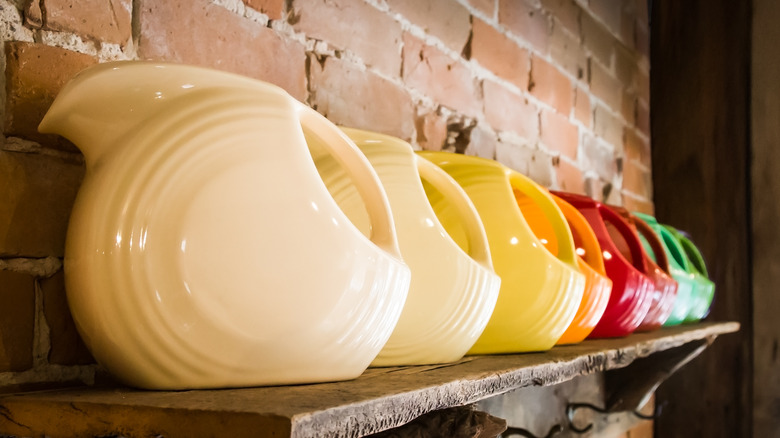9 Vintage Dishware Brands To Bring Your Kitchen Retro Charm
Vintage dishware is a great way to give any kitchen a sense of fun, retro energy, and a rich sense of the past. Vintage or antique dishes are beautiful for everyday use and displaying in your home, with offerings ranging from stacks of inexpensive pieces at flea markets and thrift stores to highly coveted and collectible items. While some styles were unique to certain manufacturers, others were offered by several companies, making finding your favorites easy, particularly if you are a collector. According to Hobby Lark, there are a number of ways to seek out and identify brands and varieties, including stamps and labels on the bottom of the piece.
Whatever your decor style, there's a perfect variety of vintage (older than 20 years) or antique (older than 100 years) dishware that will be a stunning addition to your kitchen. We've rounded up a few favorites and styles/brands to watch out for in your search, including botanical and modern plates, bowls, teacups/mugs, serving dishes, and more.
1. Pyrex
Perhaps the golden child of dishware, Pyrex dishes are highly collectible by vintage lovers and plentiful in thrift stores, antique fairs, and flea markets. The popular line was introduced by the Corning Glass Company in 1915, with Pyrex still manufacturing cookware and measuring cups today. While specific popular patterns from the 1950s through the 1970s can be rarer and more expensive, Pyrex is an affordable entry to point to collecting vintage dishware, particularly if you're going for a fun, retro, and colorful design scheme in your kitchen (via Antiques Mall).
2. Fiestaware
Fiestaware, manufactured by the Homer Laughlin China Company beginning in the 1930s, were highly collectible dishes released in a rainbow of beautiful rich shades (via Fiesta Tableware Company). Often collected and displayed today by mid-century enthusiasts, the glossy, colorful dishes were incredibly popular. While the original Fiestaware line by Laughlin ended in the early 1970s, the style was revived in the '80s and continues today in pieces very similar to the original vintage line in color and shape.
3. Fireking Jadeite
Fireking, a division of the sprawling Anchor Hocking Company, first began producing jadeite dishware in 1945. Other manufacturers like the Jeanette Glass Company and the McKee Glass Company began producing the uniquely colored green glass in the 1930s. According to American Farmhouse Style, the glowing, luminescent quality was initially achieved by adding uranium to the glass, which ended in the 1940s due to Cold War manufacturing needs. However, the milky green glass remained popular, with even many contemporary dishware companies and designers today, like Martha Stewart and Joanna Gaines, creating jadeite dishware.
4. Corell ware
A must-have in any 1970s and 1980s kitchen, these popular plate designs were everywhere, featuring a distinctive array of botanical-inspired patterns in shades of gold, green, and brown. Introduced in 1970 by the Corning company, these were some of the first dishes manufactured to be dishwasher and microwave safe. However, according to Taste of Home, they have been proven to contain higher levels of lead than other dishes and are best for display only. Because they were so popular in American homes, they are easy to find in thrift stores and flea markets.
5. Hull drip ware
While the Ohio-based Hull Pottery Company created many popular 20th-century dishware lines, décor, and collectibles, one of the most unique was their drip ware line with its signature brown or green base with a lighter drip effect along the edge. According to Collectors Weekly, the brown drip ware pattern was manufactured from 1960 through the 1980s and produced a full line of plates, bowls, mugs, vases, shakers, and other kitchen implements. Dripware pieces are plentiful in thrift stores and antique stores today, with each piece uniquely beautiful in its own way due to manufacturing techniques.
6. Spode transferware
Perhaps one of the manufacturers with the longest legacy, Spode began creating dishes and glassware in England in 1776, with creator Josiah Spode patenting the transferware process, which created elaborate and detailed designs that were then transferred onto earthenware before glazing (via Spode Museum Trust). The process was quickly replicated by other dishware companies like Wedgewood, who used it not just in the signature blue shade but to create dishware bearing other colors like red, green, brown, and gray in the 19th and 20th centuries.
7. Anchor Hocking Depression glass
Dominated by the Anchor Hocking Company, a number of other manufacturers created Depression glass during the early to mid part of the 20th century. During the 1930s, Depression glass was made affordability in mind for Americans still reeling from the economic downturn. As such, the dishes were swiftly mass-manufactured and, according to Invaluable, often have many flaws in the glass that make them interesting. Sold in several shades, including pink, green, and red, dishes were usually sold in grocery stores and given away as customer incentives at gas stations, movie houses, and pharmacies.
8. Franciscan's Starburst line
Reflecting mid-century obsessions with atomic motifs as a design element, Franciscan Ware's popular Starburst line is a beautiful addition to any mid-century modern kitchen. Created in the 1950s, these unique dishes are not only stunning for their atomic starburst pattern in turquoise, green, and gold but also for their unique, oblong curved plates, bowls, cups, and serving dishes. According to Collectors Weekly, the vibrant colors were a signature glazing process created by the manufacturers that resists cracking or crazing and looks as good today as when the dishes were made.
9. Fenton milk glass
Milk glass, which rose to popularity in the mid-20th century, was a popular, semi-translucent glass used for both dishware and décor. The Fenton Art Glass Company, founded in 1905, produced some of the most recognizable pieces with their unique hobnail pattern design that graced bowls, vases, and cups. Highly collectible today, these beautiful textured and sculptural pieces reached peak popularity in the 1960s and 1970s, according to All the Décor.









